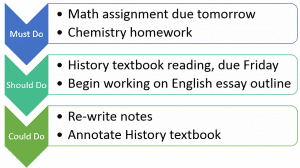Considering the high demands placed on school-aged students today, it’s no surprise that stress and anxiety are on the rise, especially for students who are most prone to perfectionism. While perfectionism affects kids of all ages, it seems to impact high school students most greatly, given the heightened expectations and requirements they face. No matter what age your student may be, however, the good news is, there are ways to help ease the level of stress experienced by students who are likely to exhibit perfectionist tendencies.

One of the most effective strategies our tutors use is the “Must Do, Should Do, Could Do” chart, which helps students categorize assignments into appropriate levels of importance. Here’s how it works: The “Must Do” column consists of all of the assignments the student absolutely MUST complete, such as homework, essays, labs, and other assignments that have to be turned in. The “Should Do” column is reserved for assignments that, though aren’t essential, will most likely benefit the student if they were to be completed. For instance, perhaps the student brings home an assignment requiring him to read pages 50 – 59. A “Should Do” associated with that assignment would be annotating those pages, as that would likely help the student learn the material better. The “Could Do” column represents tasks that the student could do but that aren’t essential. For example, say a teacher discusses an article she read about the conflict in Syria, which happens to be a subject the class is studying. While the teacher may suggest that the students check out the article if they have a chance, it isn’t an absolute must.
The chart can be a valuable tool in not only helping students stay on track, but also put emphasis on the most important assignments. In addition, parents and tutors can use the chart to develop an agreement with their students stating that nothing in the “Should Do” or “Could Do” columns can be worked on after 9:00 pm, reserving that time solely for items in the “Must Do” category, when absolutely necessary. Doing this prevents students from staying up too late to complete tasks that aren’t imperative, which can become a major issue and lead to even more stress if not addressed. Since adolescents generally require about nine hours of sleep a night, having a homework cut off time in place for perfectionist students can be extremely helpful.
While these suggestions and the “Must Do, Should Do, Could Do” chart may help you and your student deal with perfectionism, it may not be enough to completely tackle the issue. If that’s the case, we’re here to provide you with further assistance.
